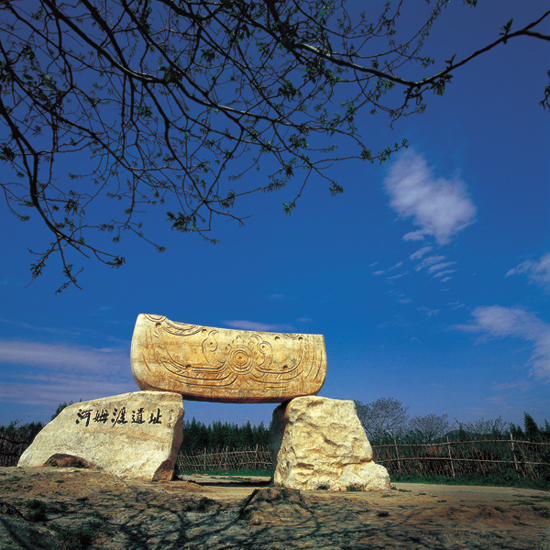Hemudu Site, a Neolithic cultural site of about 40,000 square meters, is located in the lower reaches of the Yangtze Valley. It takes its name from Hemudu Town in Yuyao city, Zhejiang province, where the site was originally discovered. The Hemudu Culture is believed to have existed between 5000 BC and 3300 BC. The Hemudu Site in Ningbo holds some of the earliest records of China's Neolithic Age.
Hemudu relics were first found in June 1973 by local villagers during construction work. As farmers were digging groundwork for a pump, they encountered many pieces of chinaware and animal bones, which revealed the mystery of a long-lost ancient village. The discovery was one of the most important archaeological events in China in the 20th century.

Utensils of the Hemudu Culture mainly consist of pottery vessels, with a few supplementary wooden wares. Primitive stone tools and bone wares carved with exquisite patterns illustrate both the practicality and aesthetics of the Hemudu. Spinning wheels, bone needles and ceramics engraved with cloth lines have been unearthed, reflecting the progress of weaving in that period. Decorative objects made of jade and fluorite materials are great in variety, with refined craftsmanship, representing the level of Neolithic culture. Red-lacquered bowls uncovered here, with a history of 7,000 plus years, are the earliest lacquer ware in China.
Habitats in the age of the Hemudu Culture were in the form of all-sized villages. Plenty of house foundations have been found at the relics, which reveal that the architecture at that time was mainly in the stilt style. Hemudu boasts the earliest stilt houses ever, enormously different from the half-crypt houses in North China from the same period.
Different from the Yangshao Culture of the Yellow River Valley, Hemudu Culture represents civilisations of the Yangtze Valley in South China as another major thread weaving through the development of ancient Chinese culture. The discovery of Hemudu relics has proved that Neolithic culture was also located in the lower reaches of the Yangtze River, serving as a principal origin of Chinese civilisation.
Since its excavation, hundreds of thousands of people from both at home and abroad have come to visit the Hemudu Site. To better preserve the site, a museum occupying some 39,000 sq m was opened in 1993. In 1999, the site was opened to the public. And in 2002, a primitive eco-zone occupying an area of 47 hectares was built to recreate a cultural scene.
Source: ningbo.chinadaily.com.cn
Editor: Ye Ke



